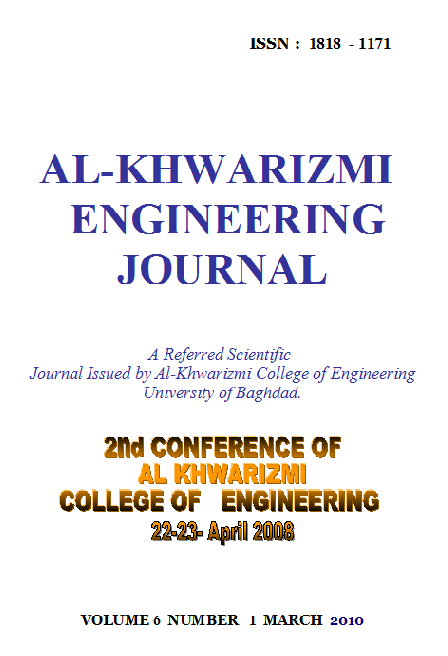Synthetic Sacks as Reinforced Fibers in the Thermosetting Composites
Abstract
This study was carried out to investigate the preparation of thermosetting polymeric blend consisting of three adhesive types, namely: epoxy, polyvinyl formal (PVF) and unsaturated polyester. Both of epoxy and PVF were used as a matrix-binder at fixed weight. Whilst unsaturated polyester was used at different weights and added to the matrix so as to produce prepared epoxy-PVF-unsaturated polyester blend. Several experiments were performed at different operating conditions, mixing speed and time at room temperature to identify the most favorable operating conditions. The optimum mixing speed and mixing time for the prepared blend were 500rpm and 5 minutes respectively.
Solid wastes-synthetic sack fibers from high volume, low cost, renewable fiber sources have been used as environmentally friendly alternatives to reinforcing fibers in composites. Many mechanical and thermal tests were carried out of the prepared blend at different weighted ratios. The optimum weighted ratio of the prepared blend for the untreated samples was characterized by the hardness and bending deflection properties and it was 0.40w/w, while for impact strength and thermal conductivity properties was 0.20w/w respectively. At these optimum weighted ratios of untreated samples with sack fibers, the maximum values of hardness and impact strength properties were 95 shore and 2.25J/cm2 respectively. On the other hand, the minimum bending deflection and thermal conductivity properties values were found to be 4mm and 0.01094W/cm.oC respectively. They showed the best bonding forces and physical interaction between two concentrations of matrix and unsaturated polyester adhesives.
Treated samples of sack fibers reinforced composites at their optimum weighted ratio showed better fiber-matrix interaction as observed from the experimental results leading to enhance and improve the mechanical (hardness, impact strength, and bending deflection) and thermal (thermal conductivity) properties when compared to the untreated sample. These improvements in treated samples with two layers of sack fibers were predominant.
Downloads
References
[2] D.H. Mueller, A. Krobjilowski, (2003), “New Discovery in the Properties of Composites
Reinforced with Natural Fibers”, Journal of Industrial Textiles, 33(2), 111-129.
[3] H. Lilholt, J.M. Lawther, (2000), “Comprehensive Composite Materials”, chapter 1.10, Elsevier Ltd.
[4] Sinha, R., (2000). Outlines of Polymer Technology.Prentice-Hall by India private Ltd. New Delhi –10001.
[5] A.K. Bledzki, O. Faruk, (2003), “Wood Fibre Reinforced Polypropylene Composites: Effect of Fibre Geometry and Ccoupling Agent on Physico-Mechanical Properties”, Applied Composite Materials, 10(6), 365-379.
[6] Sharifah, H.A., Martin, P.A., Simon, T.C. and Simon, R.P. (2005). Modified polyester resins for natural fiber composites. Compos. Sci. Technol.65:525-535.
[7] Pal, S., Mukhophadhyay, D., Sanyal S. and Mukherjea, R. (1988). Studies on process variables for natural fiber composites--effect of PEAP as interfacial agent. J. Appl. Polym. Sci. 35: 973-985.
[8] Owolabi, O., Czvikovszky, T. and Kovacs, I. (1985). Coconut fiber reinforced thermosetting plastics. J. Appl. Polym. Sci. 30:1827-1836.
[9] White, N. and Ansell, M., (1983). Straw-reinforced polyester composites. J. Mater. Sci. 18:1549-1556.
[10] Mwaikambo, L. and Bisanda, E. (1999). The performance of cotton/kapok fabric-polyester composites. Polym. Testing 18:181-198.
[11] Karnani, R., M. Krishnan and R. Narayan. (1997). Biofiber-reinforced polypropylene composites. Polymer Engineering and Science 37 (2): 476-483.
[12] Wang, B. Thesis (2004). Pre-Treatment of Flax Fibers for Use in Rotationally Molded Biocomposites. University of Saskatchewan, Saskatoon.
[13] George, J., M.S. Sreekala and S. Thomas. (2001). A review on interface modification and characterization of natural fiber reinforced plastic composites. Polymer Engineering and Science 41 (9):1471-1485.
[14] Kau, H.T. (1990). A study of the impact behavior of chopped fiber reinforced composite. Polymer Composites 11 (5):253-264.
[15] Jang, B. Z., L.C. Chen, L.R. Hwang, J.E. Hawkes and R.H. Zee. (1990). The response of fibrous composites to impact loading. Polymer Composites 11 (3):144-157.
[16] Reed, P.E. and L. Bevan. (1993). Impact damage in a composite material. Polymer Composites 14 (4):286-291.
[17] Nielsen, L.E. (1974). Mechanical Properties of Polymers and Composites. Vol. 2. New York, NY: Marcel Dekker, Inc.
[18] Shah, V. (1998). Handbook of Plastics Testing Technology. 2nd ed. New York, NY: John Wiley and Sons.
[19] A. Varada Ragulu, L. Ganga Devi, G. Babu Rao And Lakshminaryana Reddy. (2003). Journal of Reinforced Plastics and Composites, Vol. 22, No. 11/2003.
[20] Varada Ragulu, A., Babu Rao, G., Lakshminaryana Reddy. R. and Sanjeevi (2001). Journal of Reinforced Plastics and Composites, 20: 335.
[21] Park, S.J., W.B. and Lee, J.R. (1999). Polymer J., 31: 28.
[22] Harani, H., Fellahi, S. and Barkar, M. (1999). J. Appl.Polym. Sci., 71: 29.
Downloads
Published
Issue
Section
License
Copyright: Open Access authors retain the copyrights of their papers, and all open access articles are distributed under the terms of the Creative Commons Attribution License, which permits unrestricted use, distribution, and reproduction in any medium, provided that the original work is properly cited. The use of general descriptive names, trade names, trademarks, and so forth in this publication, even if not specifically identified, does not imply that these names are not protected by the relevant laws and regulations. While the advice and information in this journal are believed to be true and accurate on the date of its going to press, neither the authors, the editors, nor the publisher can accept any legal responsibility for any errors or omissions that may be made. The publisher makes no warranty, express or implied, with respect to the material contained herein.












